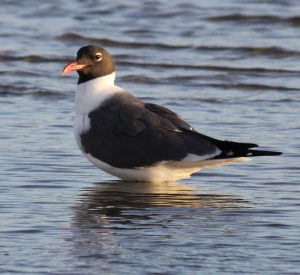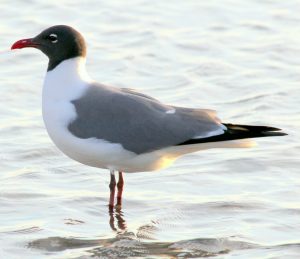Laughing Gull
General:
The first time I watched laughing gulls in any great number my family was vacationing at the outer banks in North Carolina. It was early June and they were the predominate gull species. Their call sounds just like a laugh, at least one a gull would have.
Laughing gull colonies were threatened in the late 19th century by egg and plume hunters. Now they are common and their populations have increased between 1966 and 2014, according to the North American Breeding Bird Survey.
Description:
The laughing gull is easy to identify. The gulls between 14” – 16” long and 39” – 43” wide in  wingspan. They are medium gray above and white below. During the summer adults have a black hood, with white arcs around the eye. The beak is long and red. In winter, their hood becomes a blurry gray on a white head. Their legs are reddish black. Immature gulls are much browner and more subtly patterned than adults; additionally, they take 2-3 years to gain adult plumage.
wingspan. They are medium gray above and white below. During the summer adults have a black hood, with white arcs around the eye. The beak is long and red. In winter, their hood becomes a blurry gray on a white head. Their legs are reddish black. Immature gulls are much browner and more subtly patterned than adults; additionally, they take 2-3 years to gain adult plumage.
The laughing gull resembles Franklin’s Gull but are noticeably larger with black (not red) legs and solid black outer primaries (wingtips) with no white.
Habitat:
Laughing Gulls are a coastal birds and are seldom seen very far inland. They can be found in plowed fields, garbage dumps, parking lots, and shorelines. They nest, often in large numbers, on islands near the shore but safely isolated from terrestrial predators.
Territory: The main population of this gull breeds along the Atlantic coast from Southern Canada to the Gulf Coast states, Mexico, the West Indies, Central America, and Venezuela It winters from the American Carolinas south to Brazil and Peru. A smaller population breeds in northwestern Mexico—principally the Gulf of California. Many post-breeding birds move north to southern California coast. It can be rarely seen farther north along the Pacific Coast.
Diet:
Laughing G ulls eat almost everything; they are true omnivores. They will eat garbage and discards from fishing boats. They are also very capable of finding and catching food, everything from plant material to insects to fish and shellfish, snails, crabs, and crab eggs, as well as fish, squid and berries. They often congregate in parking lots, sandy beaches, and mud bars.
ulls eat almost everything; they are true omnivores. They will eat garbage and discards from fishing boats. They are also very capable of finding and catching food, everything from plant material to insects to fish and shellfish, snails, crabs, and crab eggs, as well as fish, squid and berries. They often congregate in parking lots, sandy beaches, and mud bars.
Nesting:
They nest in salt marshes, on islands and on sandy beaches—the main requirement being safety from terrestrial predators. They form colonies up to 25,000 pairs in size, and they are occasionally joined by species such as terns, larger gulls, Black Skimmers, and American Oystercatchers.
The male and female Laughing Gull usually build their nest together. If a male cannot find a mate, he may start building a nest platform and then use it to attract a female.
The female lays 2-4 eggs that are approximately 2” long, slightly pointed at one end, colored brown with black splotches. The eggs are incubated for 20-27 days by both parents. Chicks leave the nest a few days after hatching, but their parents care for them until they fledge when they are 35 days old.